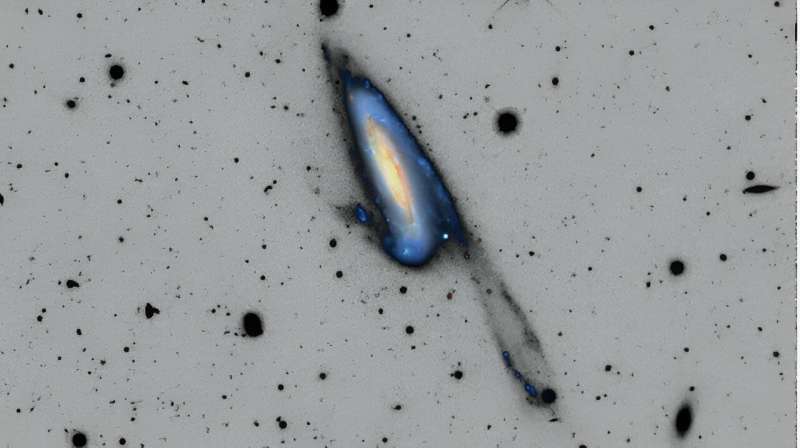This article has been reviewed according to Science X's editorial process and policies. Editors have highlighted the following attributes while ensuring the content's credibility:
fact-checked
trusted source
proofread
One step closer to unveiling dark matter with ARRAKIHS

The ARRAKIHS consortium, for which EPFL has the science lead, has just successfully passed the mission definition review of the project, a very important first milestone towards full completion of the mission preparation. ARRAKIHS is a satellite selected by ESA to address the nature of dark matter, to be launched in 2030.
When you look at the night sky, some of the stars bear witness to early formation stages of the universe and can belong to the first small galaxies formed. These structures are extremely faint in the night sky, and our current understanding is that they are also dominated by dark matter.
Dark matter is matter that has been detected gravitationally but is invisible. Identifying and characterizing these structures requires specific and dedicated observational strategies. In the next decade, ESA's second "F" space mission named ARRAKIHS, will look for these very faint structures, as they are key to unlocking the nature of dark matter.
"ESA calls it an F-mission, where F is for fast," says Pascale Jablonka of EPFL's LASTRO, who also leads the science component of ARRAKIHS. To be considered an F-class mission, ARRAKIHS has to meet a number of boundary conditions: that the total cost to ESA, including operations, is less than 175 MEuros; that the mission is stand-alone and ESA-led; that the mission will be developed using a design-to-cost approach, and that the total development time from mission selection in November 2022 to launch must be less than eight years.
Selected in 2022 by ESA as the second F mission, the European consortium members of ARRAKIHS, which is led by Spain with a very strong component from Switzerland, have been working together this past year to complete the initial phase of the mission study, called phase zero. On 27 September, ARRAKIHS passed its first milestone, the "mission design review," giving the ARRAKIHS consortium and the ESA study team the green light to move forward to the next phases of the project.
"We are very excited. It's a happy and emotional moment to get past this first phase. It means that the mission is now concretely valued. We are entering an even more active phase of the project, for which we need support from the national agencies," Jablonka explains.
Over the next two and a half years, the Mission Consortium will work together with ESA and Industry on the next study phase—the so-called mission definition or Phase A/B—which covers definition of all aspects of the mission, including science, the science instrument, the spacecraft and operations. This detailed study of mission feasibility will culminate in a review by teams of independent scientists and engineers. If successful, a recommendation will then be put forward by ESA to its Science Program Committee (made up of delegates from all ESA member states) to adopt ARRAKIHS and to move forward to implementation.
Unveiling the invisible with ARRAKIHS
According to the current standard cosmological model where gravitation is governed by Einstein's theory, the universe is made up of 27% dark matter, 68% dark energy, and only the remaining 5% is the ordinary matter as we know and see it, making up planets and stars.
The name ARRAKIHS (acronym for Analysis of Resolved Remnants of Accreted galaxies as a Key Instrument for Halo Surveys) alludes to the sci-fi planet in the novel Dune, but instead of looking for "spice," this low-earth orbit satellite will be looking to unveil one of modern physics darkest secrets. What is the nature of the dark matter? Is it hot or cold? Is it self-interacting?
Theoretical studies have shown that the signature of the nature of dark matter is imprinted in the number of faint dwarf systems around massive galaxies, such as our own, and stellar streams in their halos. ARRAKIHS will therefore target 75 such Milky Way analogs. But these analogs are so very faint in the night sky that it's important to observe them from space, away from Earth's atmosphere.
With the help of very efficient imaging technology, the scientists will unveil and characterize the stellar halo features an engineering challenge given the faintness of the astrophysical structures. The idea is to then compare these observations with various dark energy models and their predictions. Each galaxy will be observed for a total of 150 hours and their halo structures will be decoded in each and every detail.
"The mission is especially exciting for me and my collaborators since it brings together many areas of our research interests, like dark matter and galaxy evolution, but also image processing and numerical simulations," continues Jablonka, who was drawn to astrophysics because "it combines outstanding beauty and fundamental questions about the formation and evolution of physical systems."
Provided by Ecole Polytechnique Federale de Lausanne





















